Geospatial Assessment of the Post-Earthquake Hazard of the 2017 Pohang Earthquake Considering Seismic Site Effects
Abstract
:1. Introduction
2. Seismic Site Effects in Pohang Based on Geo-Data
2.1. Construction of Geo-Data in the Pohang Target Area
2.2. Site Classification Framework Based on Multivariate Site Response Parameters
2.3. Site-Specific Zonation of Seismic Site Effects in Pohang
3. Post-Earthquake Impact Evaluation of Damaged Buildings
4. Spatial Correlations between Earthquake Damage and Seismic Site Effect
5. Conclusions
Author Contributions
Funding
Acknowledgments
Conflicts of Interest
References
- Korea Meteorological Administration (KMA). Earthquake: Notice, Korea Meteorological Administration. Available online: http://www.kma.go.kr/weather/earthquake_volcano/ (accessed on 28 January 2019).
- Korea Institute of Geoscience and Mineral Resources (KIGAM). Earthquakes in the Southeast Korean Peninsula: focusing on the 2016 Gyeongju and the 2017 Pohang Earthquakes; KIGAM: Daejeon, Korea, 2018. (In Korean) [Google Scholar]
- Hough, S.E. Initial assessment of the intensity distribution of the 2011 Mw 5.8 Mineral, Virginia, earthquake. Seismol. Res. Lett. 2012, 83, 649–657. [Google Scholar] [CrossRef]
- Sun, C.G. Geotechnical Information System and Site Amplification Characteristics for Earthquake Ground Motions at Inland of the Korean Peninsula; Seoul National University: Seoul, Korea, 2004. [Google Scholar]
- Green, R.A.; Olson, S.M.; Cox, B.R.; Rix, G.J.; Rathje, E.; Bachhuber, J.; French, J.; Lasley, S.; Martin, N. Geotechnical aspects of failures at Port-au-Prince seaport during the 12 January 2010 Haiti earthquake. Earthq. Spectra 2011, 27, S43–S65. [Google Scholar] [CrossRef]
- Building Research Institute. Guideline for Damage Survey Methods of Earthquake Disaster Related with Buildings and House; Building Research Institute: Ibaraki-ken, Japan, 2002. [Google Scholar]
- Applied Technology Council (ATC). Procedures for Post-Earthquake Safety Evaluation of Buildings; ATC: Redwood City, CA, USA, 1989. [Google Scholar]
- Sun, C.G.; Chun, S.H.; Ha, T.G.; Chung, C.K.; Kim, D.S. Development and application of a GIS-based tool for earthquake-induced hazard prediction. Comput. Geotech. 2008, 35, 436–449. [Google Scholar] [CrossRef]
- Sun, C.G.; Kim, H.S.; Cho, H.I. Geo-Proxy-Based Site Classification for Regional Zonation of Seismic Site Effects in South Korea. Appl. Sci. 2018, 8, 314. [Google Scholar] [CrossRef]
- Kim, K.H.; Ree, J.H.; Kim, Y.; Kim, S.; Kang, S.Y.; Seo, W. Assessing whether the 2017 Mw 5.4 Pohang earthquake in South Korea was an induced event. Science 2018, eaat6081. [Google Scholar] [CrossRef]
- Sun, C.G.; Kim, H.S. GIS-based regional assessment of seismic site effects considering the spatial uncertainty of site-specific geotechnical characteristics in coastal and inland urban areas. Geomat. Nat. Hazards Risk 2017, 8, 1592–1621. [Google Scholar] [CrossRef] [Green Version]
- Kim, H.S.; Sun, C.G.; Cho, H.I. Geospatial big data-based geostatistical zonation of seismic site effects in Seoul metropolitan area. ISPRS Int. J. Geo-Inf. 2017, 6, 174. [Google Scholar] [CrossRef]
- Öztürk, C.A.; Nasuf, E. Geostatistical assessment of rock zones for tunneling. Tunn. Undergr. Space Technol. 2002, 17, 275–285. [Google Scholar] [CrossRef]
- Sun, C.G.; Kim, H.S. Geostatistical assessment for the regional zonation of seismic site effects in a coastal urban area using a GIS framework. Bull. Earthq. Eng. 2016, 14, 2161–2183. [Google Scholar] [CrossRef]
- Rodriguez-Marek, A.; Bray, J.D.; Abrahamson, N.A. A geotechnical seismic site response evaluation procedure. In Proceedings of the 12th World Conference on Earthquake Engineering, Oakland, New Zealand, 30 January–4 February 2000. [Google Scholar]
- Sun, C.G. Seismic zonation on site responses in Daejeon by building geotechnical information system based on spatial GIS framework. J. Korean Geotech. Soc. 2009, 25, 5–19. [Google Scholar]
- Kim, D.S.; Chung, C.K.; Sun, C.G.; Bang, E.S. Site assessment and evaluation of spatial earthquake ground motion of Kyeongju. Soil Dyn. Earthq. Eng. 2002, 22, 371–387. [Google Scholar] [CrossRef]
- Goretti, A.; Di Pasquale, G. Building inspection and damage data for the 2002 Molise, Italy, earthquake. Earthq. Spectra 2004, 20, S167–S190. [Google Scholar] [CrossRef]
- Applied Technology Council (ATC). Addendum to ATC 20 Post-Earthquake Building Safety Evaluation Procedure; ATC: Redwood City, CA, USA, 1989. [Google Scholar]
- Bird, J.F.; Bommer, J.J.; Bray, J.D.; Sancio, R.; Spence, R.J.S. Comparing loss estimation with observed damage in a zone of ground failure: A study of the 1999 Kocaeli earthquake in Turkey. Bull. Earthq. Eng. 2004, 2, 329–360. [Google Scholar] [CrossRef]
- Atkinson, G.M.; Kaka, S.I. Relationships between felt intensity and instrumental ground motion in the central United States and California. Bull. Seismol. Soc. Am. 2007, 97, 497–510. [Google Scholar] [CrossRef]
- Hazus, E.L.E.M. Technical Manual; National Institute of Building for the Federal Emergency Management Agency: Washington, DC, USA, 1997.
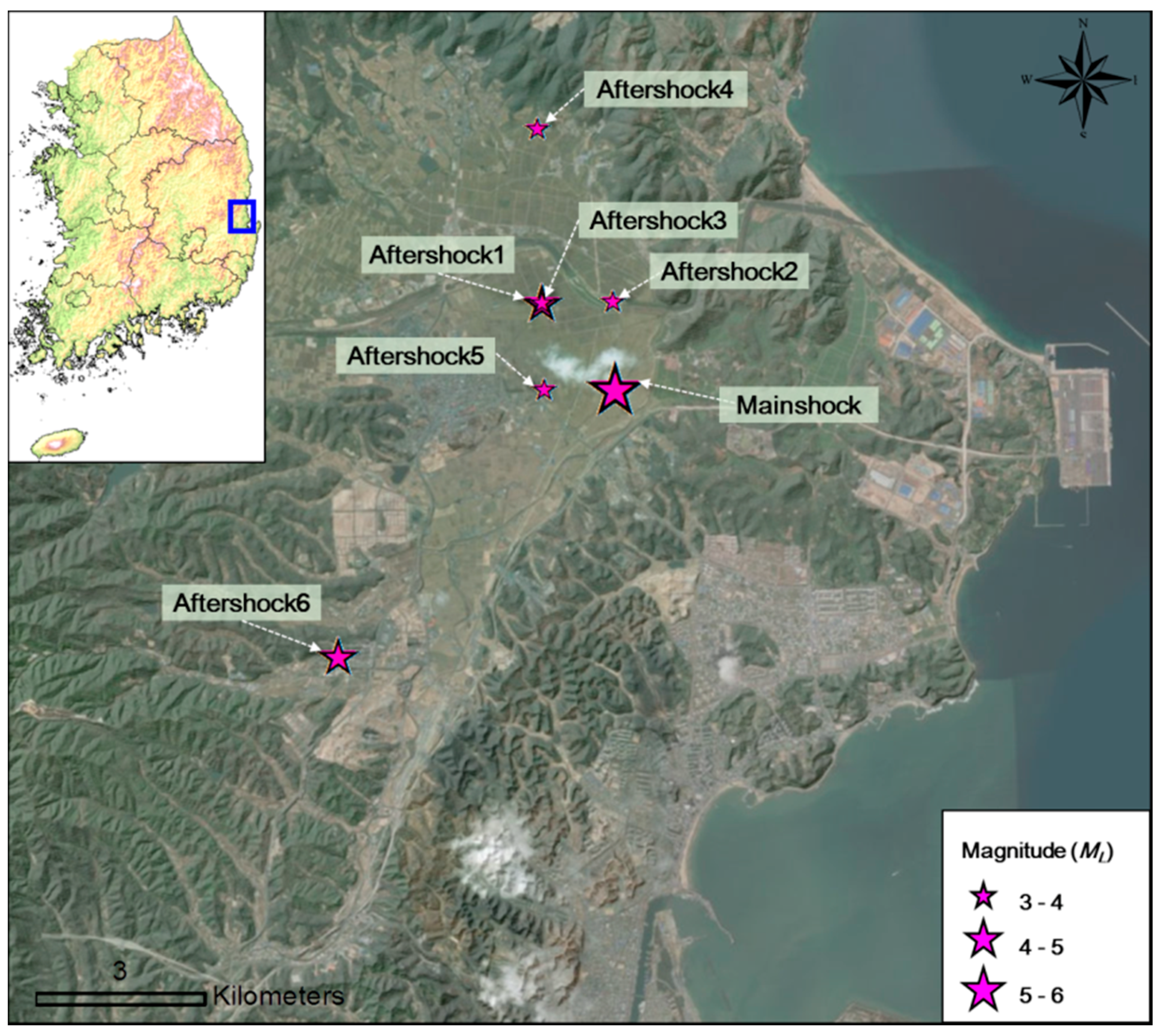




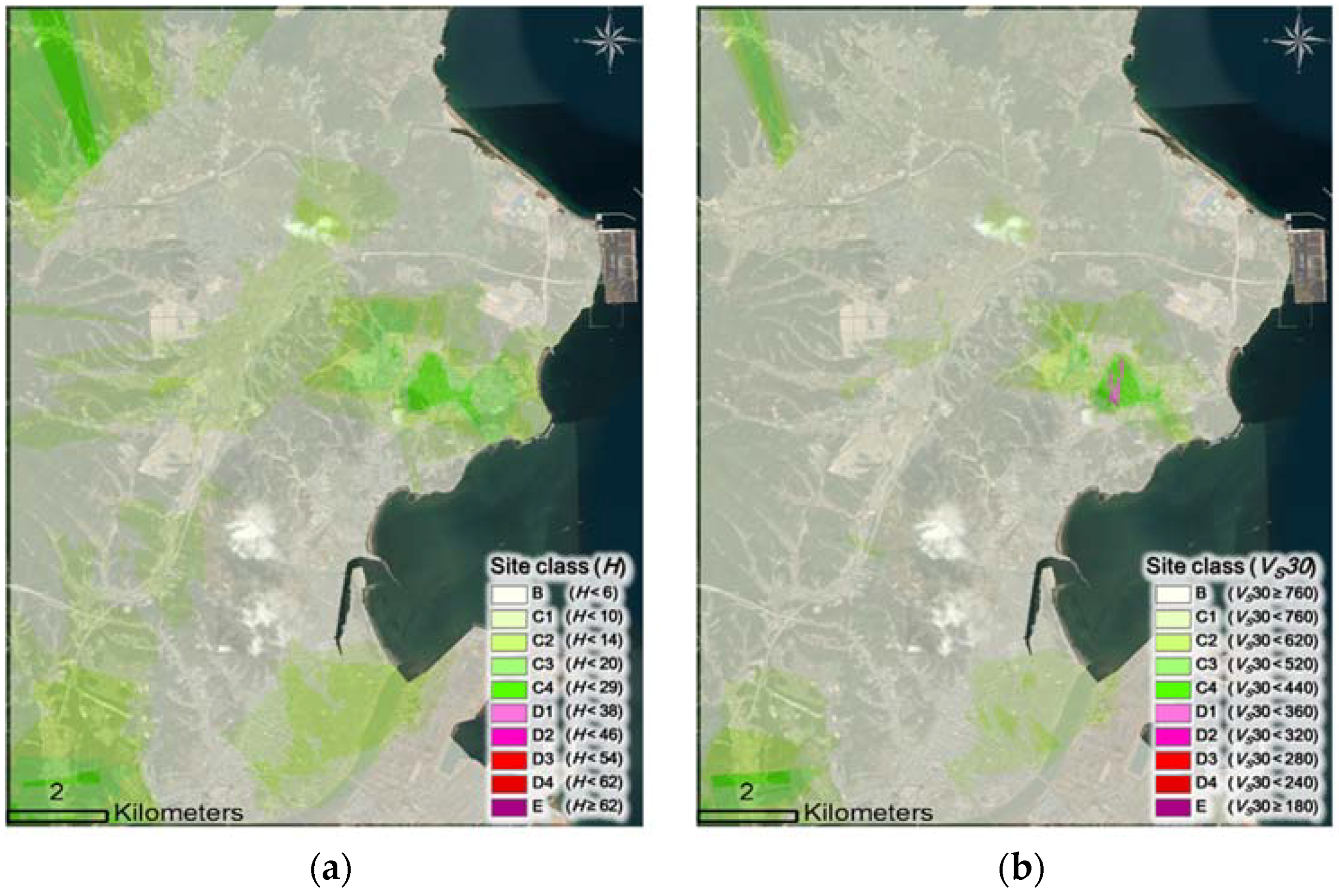

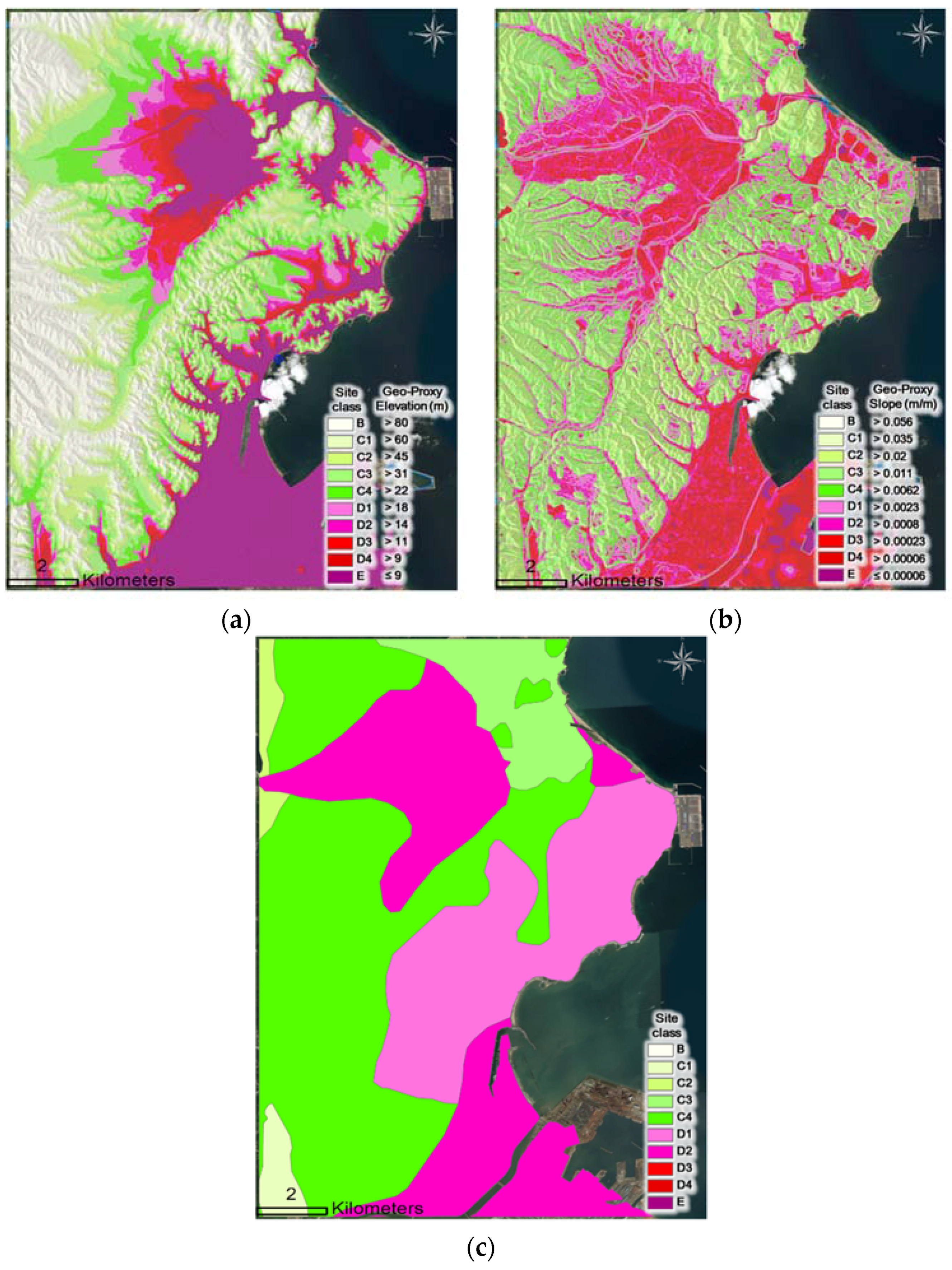
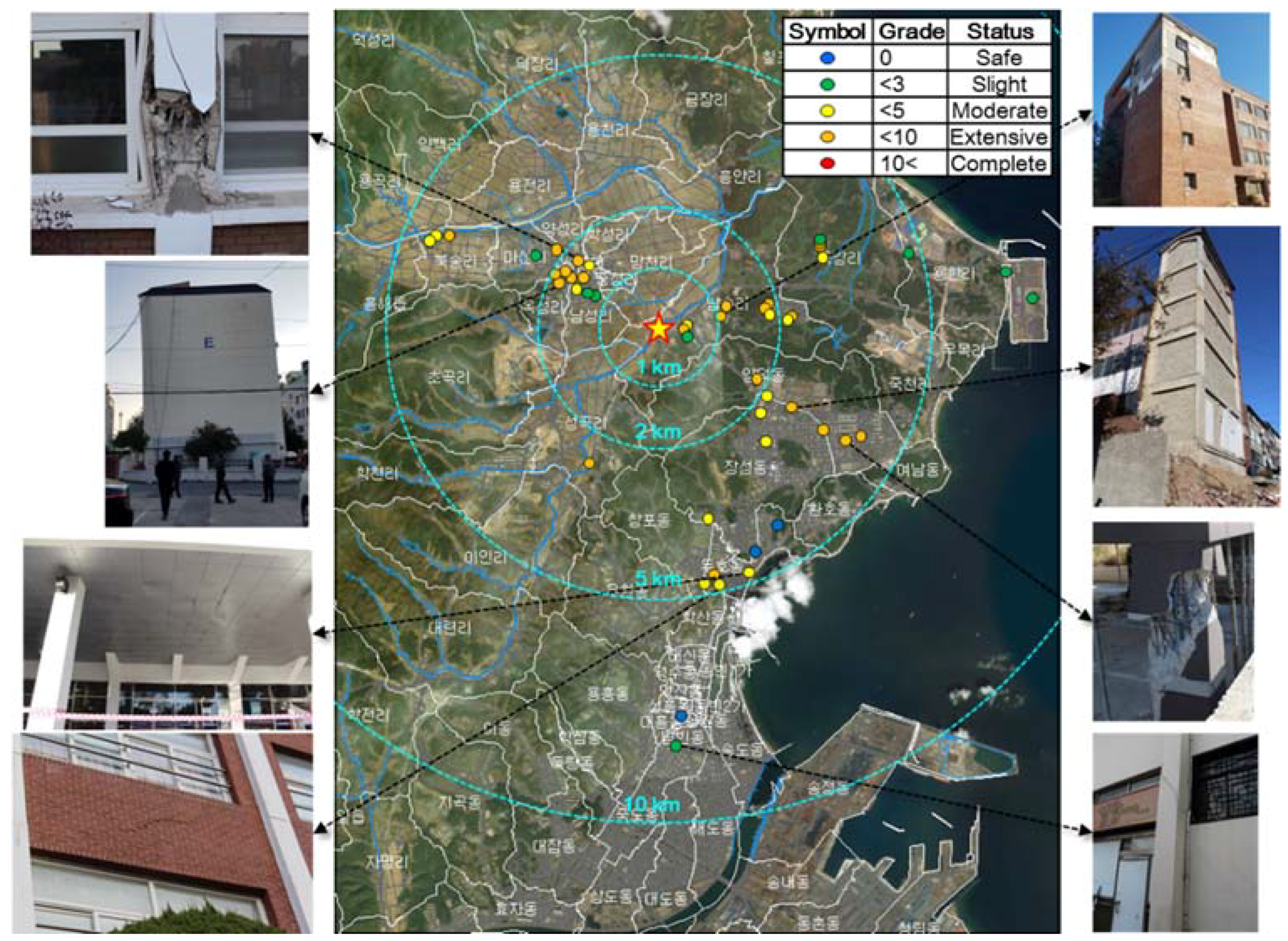
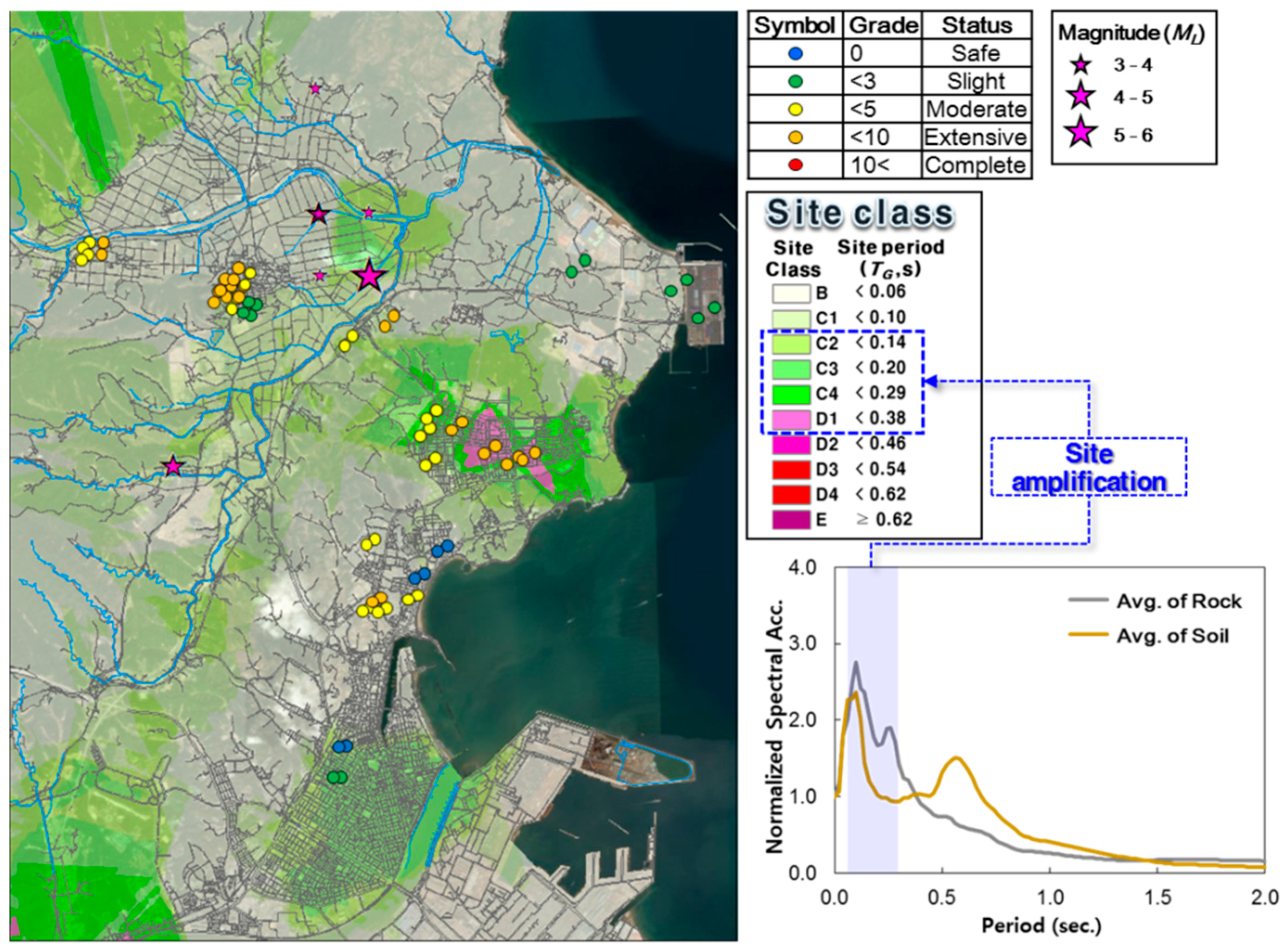
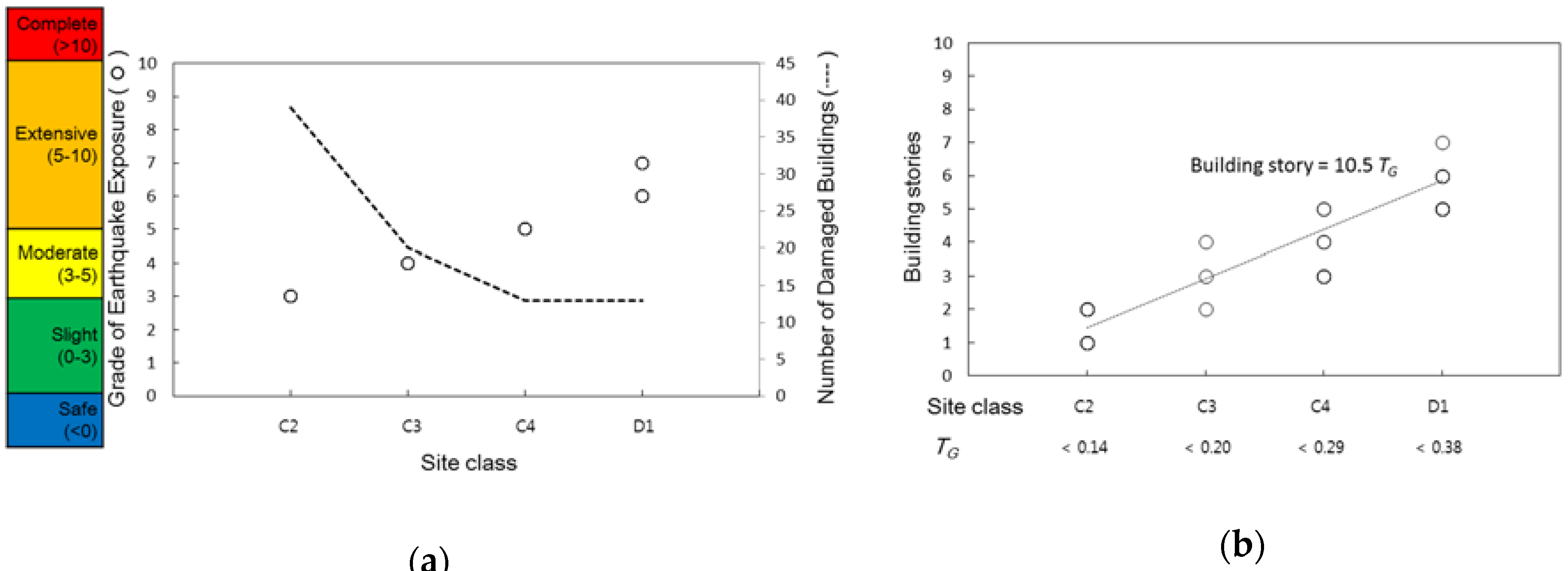
| Earthquake | Date and Time of Occurrence (KST) | Epicenter | Depth (km) | ML | |
|---|---|---|---|---|---|
| Latitude | Longitude | ||||
| Mainshock | 2017-11-15 14:29:31 | 36.11 | 129.37 | 7.0 | 5.4 |
| Aftershock1 | 2017-11-15 16:49:30 | 36.12 | 129.36 | 10.0 | 4.3 |
| Aftershock2 | 2017-11-16 09:02:42 | 36.12 | 129.37 | 8.0 | 3.6 |
| Aftershock3 | 2017-11-19 23:45:47 | 36.12 | 129.36 | 9.0 | 3.5 |
| Aftershock4 | 2017-11-20 06:05:15 | 36.14 | 129.36 | 12.0 | 3.6 |
| Aftershock5 | 2017-12-25 16:19:22 | 36.11 | 129.36 | 10.0 | 3.5 |
| Aftershock6 | 2018-02-11 05:03:03 | 36.08 | 129.33 | 9.0 | 4.6 |
| Generic Description | Site Class | Geotechnical Criteria | Geo-Proxy-Based Criteria | ||||||
|---|---|---|---|---|---|---|---|---|---|
| H (m) | VS30 (m/s) | TG (s) | f0 (Hz) | Slope (%) | Elevation (m) | Geology | |||
| Rock | B | <6 | >760 | <0.06 | >16.67 | >5.6 | >80 | Plutonic/metamorphic rocks | |
| Weathered Rock and Very Stiff Soil | C | C1 | <10 | >620 | <0.10 | >10.00 | >3.5 | >60 | Cretaceous fine-grained sediments |
| C2 | <14 | >520 | <0.14 | >7.14 | >2.0 | >45 | Sheared/weathered crystalline rocks | ||
| Intermediate Stiff Soil | C3 | <20 | >440 | <0.20 | >5.00 | >1.1 | >31 | Oligocene–Cretaceous sedimentary rocks | |
| C4 | <29 | >360 | <0.29 | >3.45 | >0.62 | >22 | Coarse-grained younger material | ||
| Deep Stiff Soil | D | D1 | <38 | >320 | <0.38 | >2.63 | >0.23 | >18 | Miocene fine-grained sediments |
| D2 | <46 | >280 | <0.46 | >2.17 | >0.08 | >14 | Coarse younger alluvium | ||
| D3 | <54 | >240 | <0.54 | >1.85 | >0.023 | >11 | Holocene alluvium | ||
| D4 | <62 | >180 | <0.62 | >1.61 | >0.006 | >9 | Fine-grained alluvial/estuarine deposits | ||
| Deep Soft Soil | E | ≥62 | ≤180 | ≥0.62 | ≤1.61 | ≤0.006 | ≤9 | Inter-tidal mud | |
| Criteria for Geotechnical Hazard | Criteria for Structure Hazard | ||
|---|---|---|---|
| Geotechnical Damage | Grade of Geotechnical Hazard | Structure Damage | Grade of Structure Hazard |
| Negligible | 0 | Negligible | 0 |
| Liquefaction settlements < 50 mm | 1 | Hairline crack at in fill/column joints | 1 |
| Liquefaction settlements 50–200 mm | 2 | Hairline cracks in structure & in-fill | 2 |
| Liquefaction settlements > 200 mm | 3 | Some frame elements yielded. Larger cracks in in-fill | 3 |
| Vertical foundation movement < 50 mm | 4 | Larger flexural cracks and spalling. Some crushing of in-fill at corners | 4 |
| Vertical foundation movement 50–100 mm | 5 | Some failure to non-ductile elements. Most in-fill exhibits large cracks, minor falls | 5 |
| Vertical foundation movement > 100 mm | 6 | Many failures to non-ductile elements. Some in-fill fallen or bulged | 6 |
| Slight horizontal spreading < 25 mm | 7 | Most non-ductile elements failed. Severe deformation. Most in-fill fallen or severely damaged | 7 |
| Moderate horizontal spreading 25 to 100 mm | 8 | Full structure in danger of collapse | 8 |
| Severe horizontal spreading > 100 mm | 9 | Destruction | 9 |
| Category of Structure | PGA (g) | TG-Based Site Class | Structure Type (Stories) | Geotechnical Manifestation | Grade of Geotechnical Hazard (A) | Structure Manifestation | Grade of Structural Hazard (B) | Grade of Earthquake Exposure (A + B) |
|---|---|---|---|---|---|---|---|---|
| Elementary school | 0.21 | C3 | Concrete Moment Frame (3) | Subsidence (2~7 cm) | 1 | Major failures to non-ductile element | 7 | 8 (Extensive) |
| Apartment | 0.2 | C4 | Steel Moment Frame (5) | Subsidence (15~25 cm) | 2 | Some failures to non-ductile element | 6 | 8 (Extensive) |
| University | 0.2 | C3 | Concrete Moment Frame (6) | - | 1 | Larger flexural cracks | 4 | 4 (Moderate) |
| Row house | 0.21 | D1 | Concrete Moment Frame (3) | - | 0 | Some failures to non-ductile element | 5 | 5 (Extensive) |
| Bus terminal | 0.12 | C1 | Concrete Moment Frame (2) | - | 0 | Hairline cracks at in fill | 2 | 2 (Slight) |
| Apartment | 0.15 | C1 | Precast Concrete Frames (12) | - | 0 | Hairline cracks at in fill | 1 | 1 (Slight) |
| Row house | 0.17 | C1 | Unreinforced Masonry Bearing Walls (5) | - | 0 | Hairline cracks at in fill | 2 | 2 (Slight) |
| Hospital | 0.13 | C2 | Concrete Moment Frame (5) | - | 0 | Hairline cracks at in fill | 1 | 1 (Slight) |
| Market | 0.22 | C3 | Unreinforced Masonry Bearing Walls (2) | - | 0 | Larger flexural cracks | 5 | 5 (Extensive) |
| Row house | 0.21 | C3 | Unreinforced Masonry Bearing Walls (4) | - | 0 | Hairline cracks at in fill | 2 | 2 (Slight) |
| Detached house | 0.18 | C3 | Unreinforced Masonry Bearing Walls (2) | - | 0 | Hairline cracks at in fill | 3 | 3 (Moderate) |
© 2018 by the authors. Licensee MDPI, Basel, Switzerland. This article is an open access article distributed under the terms and conditions of the Creative Commons Attribution (CC BY) license (http://creativecommons.org/licenses/by/4.0/).
Share and Cite
Kim, H.-S.; Sun, C.-G.; Cho, H.-I. Geospatial Assessment of the Post-Earthquake Hazard of the 2017 Pohang Earthquake Considering Seismic Site Effects. ISPRS Int. J. Geo-Inf. 2018, 7, 375. https://doi.org/10.3390/ijgi7090375
Kim H-S, Sun C-G, Cho H-I. Geospatial Assessment of the Post-Earthquake Hazard of the 2017 Pohang Earthquake Considering Seismic Site Effects. ISPRS International Journal of Geo-Information. 2018; 7(9):375. https://doi.org/10.3390/ijgi7090375
Chicago/Turabian StyleKim, Han-Saem, Chang-Guk Sun, and Hyung-Ik Cho. 2018. "Geospatial Assessment of the Post-Earthquake Hazard of the 2017 Pohang Earthquake Considering Seismic Site Effects" ISPRS International Journal of Geo-Information 7, no. 9: 375. https://doi.org/10.3390/ijgi7090375





